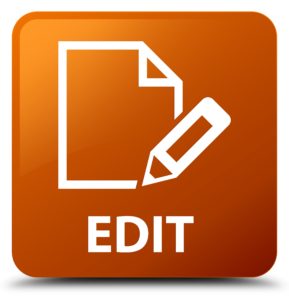An introduction to editing for non-editors (Part 1) – content editing
 In an ideal world, we’d all work in proposal shops with dedicated proposal writers and editors. The proposal writers would interview SMEs to craft compelling, clean text, and the editor would not only fix grammar mistakes, but also re-write as needed for one voice, clarity, and impact.
In an ideal world, we’d all work in proposal shops with dedicated proposal writers and editors. The proposal writers would interview SMEs to craft compelling, clean text, and the editor would not only fix grammar mistakes, but also re-write as needed for one voice, clarity, and impact.
Unfortunately, many of us work in proposal shops without these resources. In these cases, project staff write proposals in their spare time, and the proposal manager is often responsible for managing the proposal, re-writing text as needed, and editing the document before submission.
Teaching regular contributors how to edit their own work will improve their writing skills over time and reduce the amount of re-work required by the proposal manager. A proposal manager should introduce the concept of self-editing work at the proposal kick-off meeting and share this article to jump-start the process. If you’re a proposal manager tasked with editing, you might even use this article yourself.
Types of editing
There are two basic types of editing: content editing and copy editing. Content editing, also referred to as substantive editing or development editing, involves big-picture writing concerns such as organization, paragraph length, consistency, and tone. Essentially, a good content editor makes writing flow.
Copy editing looks at the grammatical details of written text, correcting errors and improving word usage and sentence structure. Both kinds of editing are important, but content editing must happen first. There’s no point in tweaking wording to perfectly transition from one sentence to the next if a content editor is going to delete one of those sentences or move them into different paragraphs.
In this article, I’ll explore content editing in detail, but be on the lookout for part 2 in the series, which will focus on copy editing.
Content editing
Content editing your own writing is difficult. You know what you’re trying to say, so you read your text exactly as you intended—the organization makes sense, the tone is perfect, and you don’t see any gaps or missing information. The only way to get around this is to review your writing with fresh eyes after enough time has passed that you’ve basically forgotten what you wrote. Unfortunately, we almost never have time for this approach in proposals. Instead, I recommend that writers swap sections and edit each other’s work prior to a formal color team review. Use the following rubric as a guide for content editing.
| Writing quality | Guiding questions/actions |
| Well-organized. A good proposal section should be laid out logically and clearly. Use subheadings to make the underlying organization clear; at the same time, paragraphs should transition so clearly from one to the next that subheadings aren’t necessary. |
|
| Consistency and one voice. Clear writing uses a consistent vocabulary and sentence structure. This means labor categories should be standard (a person should not be referred to as a project manager in one section and a project lead in another), tools and key features should be referred to in the same way, and processes should align from section to section. Everyone should refer to their company (or team name) the same way.
Sentence structure should also be similar from section to section. If one section only uses long, complex sentences, and another section uses mostly short and simple sentences, readers will feel like their narrator has changed unexpectedly. |
|
| Tone. Well-written proposals take the tone of sharing information with a professional, non-specialist peer. They use clear and simple language, but don’t talk down to the reader. They are professional without being overly formal—it’s ok to use personal pronouns like you and we. |
|
| Accuracy and correctness. Text with inaccuracies loses credibility with evaluators. Make sure your facts, proof points, descriptions, and stories are correct. |
|
| Proportionality. Paragraph lengths and the level of detail within paragraphs should be proportional to the customer requirements. Check the level of detail in sections L, M, and C (or their equivalent) to be sure the writing goes into detail where the RFP also goes into detail. Nothing is worse than providing only a few sentences to address a requirement a customer prioritized in the evaluation criteria or SOW. |
|
| Completeness. Verifying completeness of a proposal includes both the text’s technical compliance (responding to all the shall statements) and providing complete and thorough information; a reader shouldn’t finish a document wishing there had been additional material or context provided. |
|
| Well-written. Research shows that adults often learn better from positive feedback than negative feedback. Be sure to identify all the aspects that went well, caught your attention, or were especially well-written. |
|
What other writing qualities or guiding questions would you include for content editing? Email your thoughts to me at JQuigley@LohfeldConsulting.com, and I’ll include them in part two of this series.
 With a Master’s in Rhetoric and Composition, Julia Quigley has created proposal writing strategies and conducted training to help subject matter experts understand how to respond clearly and compellingly to solicitation requirements. Prior to joining Lohfeld Consulting Group, Julia managed proposals for small and mid-sized federal contractors and taught persuasive writing classes at Texas State University. She applies the lessons she taught as well as lessons learned to all her proposal and training projects.
With a Master’s in Rhetoric and Composition, Julia Quigley has created proposal writing strategies and conducted training to help subject matter experts understand how to respond clearly and compellingly to solicitation requirements. Prior to joining Lohfeld Consulting Group, Julia managed proposals for small and mid-sized federal contractors and taught persuasive writing classes at Texas State University. She applies the lessons she taught as well as lessons learned to all her proposal and training projects.
Paperback or Kindle
10 steps to creating high-scoring proposals
by Bob Lohfeld
contributors Edited by Beth Wingate
Subscribe to our free ebrief
Teaming friends, frenemies, and enemies—12 tips to mitigate harmful effects
Did you know that contracting officers spend up to 20% of their time mitigating disputes between teaming partners? In an informal poll we conducted on LinkedIn last month, 40% of respondents classified their teaming partners as “frenemies” on their last bid.
Explore Further
- Advice (446)
- AI (5)
- APMP (17)
- Business Development (198)
- Capture Management (197)
- Favorite Books (5)
- Go-to-Market (27)
- Graphics (6)
- Lohfeld Books (3)
- Past Performance (58)
- Post-submission Phase (15)
- Pre-RFP Preparation (211)
- Proposal Management (270)
- Proposal Production (60)
- Proposal Reviews (27)
- Proposal Writing (77)
- Pursuit Phase (89)
- Research Report (2)
- Resources (60)
- Tools & Tips (259)
- Training (10)
- Uncategorized (220)

Sign Up for INSIGHTS and Download your FREE book
We'd love to help you with your proposals. Enjoy our complimentary Lohfeld Consulting Group Capture & Proposal Insights & Tips book with your FREE subscription to our Insights Newsletter.
GET YOUR FREE BOOK




